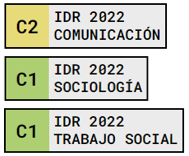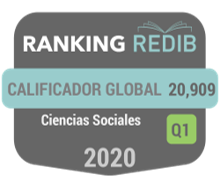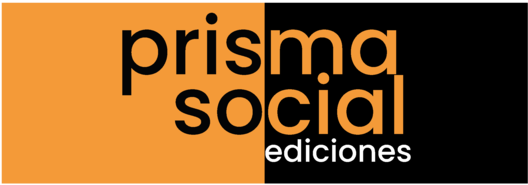El libro-álbum premiado: análisis crítico de las ilustraciones en el panorama español 2000-2017
Palabras clave:
Libro-álbum, ilustración, campo literario, canonicidad, saturación, técnica, EspañaResumen
El libro-álbum representa una potente y motivadora puerta de acceso a la literatura escrita para el público infantil y juvenil. Su fuerza estética capta la atención del lector y le introduce en una historia fruto del diálogo entre texto e ilustraciones. En las últimas décadas, este género se ha convertido en protagonista habitual de espacios de mediación lectora, tanto en contextos educativos como en el ámbito privado. De esta amplia aceptación social deriva la importancia del álbum como herramienta de enculturación de las nuevas generaciones y por ello resulta imprescindible un estudio crítico del campo. Este trabajo plantea un análisis del panorama de la ilustración infantil española desde el año 2000, examinando un conjunto de obras cuya calidad ha sido establecida por varias organizaciones especializadas (N=69). Los resultados muestran la existencia de tendencias relacionadas con la saturación de los colores, el nivel de detalle y las técnicas utilizadas; tendencias que podrían responder a la concepción adulta de la infancia.
Descargas
Citas
Arizpe, E., & Styles, M. (2016). Children Reading Picturebooks : Interpreting Visual Texts. London and New York: Routledge.
Beauvais, C. (2013). The Problem of “Power”: Metacritical Implications of Aetonormativity for Children’s Literature Research. Children’s Literature in Education. https://doi.org/10.1007/s10583-012-9182-3
Bosch, E. (2018). Wordless Picturebooks. In B. Kümmerling-Meibauer (Ed.), The Routledge Companion to Picturebooks. Oxon; New York: Routledge.
Bourdieu, P. (1990). El campo literario. Prerrequisitos críticos y principios de método. Criterios, 20–42.
Bravo Villasante, C. (1983). Historia de la literatura infantil española. Madrid: Doncel.
Chambers, A. (2011). Tell Me (Children, Reading & Talk) with The Reading Environment. Stroud, Gloucestershire: Thimble Press.
Colomer, T. (2002). Siete llaves para valorar las historias infantiles. Madrid: Fundación Germán Sánchez Ruipérez.
Colomer, T. (2010). Introducción a la literatura infantil y juvenil actual. Madrid: Sintesis.
Correro Iglesias, C., & Colomer, T. (2015). Literatura na Educação Infantil: acervos, espaços e mediações. In VVAA (Ed.), Literatura na Educaçâo infantil: acervos, espaços e mediaçôes. Belo Horizonte: Universidade Federal de Minas Gerais/ Ministério da Educaçâo Brasil.
Dondis, D. A. (2011). La sintaxis de la imagen. Barcelona: Gustavo Gili.
Duran, T. (2009). Álbumes y otras lecturas : Análisis de los libros infantiles. Barcelona: Octaedro.
Eco, U. (1979). Lector in fabula. La cooperación interpretativa en el texto narrativo. Barcelona: Editorial Lumen.
Even-Zohar, I. (1990). Polysystem Theory. Poetics Today, 11(1), 9–26.
Ewers, H.-H. (2009). Fundamental Concepts of Children’s Literature Research. New York/Abingdon: Routledge. https://doi.org/10.4324/9780203877524
Garcia-Gonzalez, M. (2017). Origin Narratives: The Stories We Tell Children about immigration and International Adoption. New York: Routledge.
García Padrino, J. (2004). Formas y colores : la ilustración infantil en España. Cuenca: Ediciones de la Universidad de Castilla-La Mancha.
Golden, J. M. (1990). The narrative symbol in childhood literature: Explorations in the construction of text. Berlin; New York: Mouton de Gruyter.
Hidalgo Rodríguez, M. del C. (1999). La ilustración infantil española en los años 90. Los personajes y su representación. Universidad de Granada.
Jones, K. (2007). Getting Rid of Children’s Literature. The Lion and the Unicorn, 30(3), 287–315. https://doi.org/10.1353/uni.2006.0033
Kiefer, B. (1988). Picture books as contexts for literary, aesthetic, and real world understandings. Language Arts, 65(3), 260–271.
Kress, G., & van Leeuwen, T. (2006). Reading Images: The Grammar of Visual Design. London: Routledge.
Lewis, D. (2012). Reading Contemporary Picturebooks: Picturing Text. Hoboken: Taylor and Francis.
Lindgren, A., & Powell, E. S. (2017). “Why do we write children’s books?” by Astrid Lindgren. Children’s Literature, 45, 188–195.
Lluch, G. (2010). Cómo seleccionar libros para niños y jóvenes: Los comités de valoración en las bibliotecas escolares y públicas. Gijón: Trea.
Lowenfeld, V., & Brittain, W. L. (1964). Creative and Mental Growth. New York: The Macmillan Company.
Mínguez-López, X. (2012). La definición de la LlJ desde el paradigma de la didáctica de la lengua t la literatura. AILIJ (Anuario de Investigación En Literatura Infantil y JUvenil, 10, 87–106.
Moebius, W. (1986). Introduction to Picturebook Codes. Word & Image, 2(2), 141–151.
Nikolajeva, M. (2010). Power, Voice and Subjectivity in Literature for Young Readers. New York: Routledge.
Nikolajeva, M., & Scott, C. (2006). How Picturebooks Work. New York: Routledge.
Nodelman, P. (1988). Words about Pictures: The Narrative Art of Children’s Picture Books. Athens: University of Georgia Press.
Nodelman, P. (2008). The Hidden Adult: Defining Children’s Literature. Baltimore: Johns Hopkins University Press.
Nodelman, P. (2010). Las narrativas de los libros-álbum y el proyecto de literatura infa. In T. Colomer, B. Kümmerling-Meibauer, & M. C. Silva-Díaz (Eds.), Cruce de miradas: Nuevas aproximaciones al libro-álbum (pp. 18–33). Barcelona: Banco del Libro-GRETEL.
Observatorio de la Lectura y el Libro. (2018). Los libros infantiles y juveniles en España.
Painter, C., Martin, J. R., & Unsworth, L. (2014). Reading Visual Narratives: Image Analysis of Children’s Picture Books. Sheffield, UK; Bristol, USA: Equinox.
Pantaleo, S. (2016a). Critical Thinking and Young Children’s Exploration of Picturebook Artwork. Language and Education. https://doi.org/10.1080/09500782.2016.1242599
Pantaleo, S. (2016b). Primary Students’ Understanding and Appreciation of the Artwork in Picturebooks. Journal of Early Childhood Literacy, 16(2), 228–255. https://doi.org/10.1177/1468798415569816
Rose, J. (1984). The case of Peter Pan, or, The impossibility of children’s fiction. London: Macmillan. Retrieved from https://books.google.es/books?hl=es&lr=&id=ao1045IYK8sC&oi=fnd&pg=PR9&dq=jacqueline+rose+peter+pan&ots=WUFbEB2LRx&sig=maRP8okU1V1-phN1gcCPUv1MawE#v=onepage&q=jacqueline rose peter pan&f=false
Rudd. (2005). Theorising and theories. How does children’s literature exist? In P. Hunt (Ed.), Understanding Children’s Literature (pp. 15–29). London and New York: Routledge.
Rudd, D., & Pavlik, A. (2010). The (Im)Possibility of Children’s Fiction: Rose Twenty-Five Years On. Children’s Literature Association Quarterly, 35(3), 223–229.
Salisbury, M. (2014). Ilustración de libros infantiles: Cómo crear imágenes para su publicación. Barcelona: Editorial Acanto.
Scott, C. (2014). Dual Audience in Picturebooks. In S. L. Beckett (Ed.), Trascending Boundaries: Writing for a Dual Audience of Children and Adults (p. 286). London.
Shavit, Z. (2014). The Double Attributon of Texts for Children and How It Affects Writing for Children. In S. L. Beckett (Ed.), Trascending Boundaries: Writing for a Dual Audience of Children and Adults (p. 286). London: Routledge.
Silva-Díaz, M. C. (2005). Libros que enseñan a leer: Álbumes metaficcionales y conocimiento literario. Universitat Autònoma de Barcelona.
Sipe, L. (1998). How Picture Books Work : A Semiotically Framed Theory of Text-Picture Relationships. Children’s Literature in Education, 29(2), 97–108. https://doi.org/10.1023/A:1022459009182
Sipe, L. (2001). Picturebooks as Aesthetic Objects. Literacy Teaching and Learning, 6(1), 23–42.
Van der Linden, S. (2015). Álbum[es]. Barcelona: Ekaré.
Vásquez Rodríguez, F. (2014). Elementos para una lectura del libro álbum. Enunciación, 19(2), 3. https://doi.org/10.14483/udistrital.jour.enunc.2014.2.a12
Zipes, J. (2001). Sticks and Stones: The Troublesome Success of Children’s Literature from Slovenly Peter to Harry Potter. New York: Routledge.
Descargas
Publicado
Cómo citar
Número
Sección
Licencia
Los autores/as que publiquen en esta revista aceptan las siguientes condiciones:
- Los autores/as conservan los derechos de autor.
- Los autores/as ceden a la revista el derecho de la primera publicación. La revista también posee los derechos de edición.
- Todos los contenidos publicados se regulan mediante una Licencia Atribución/Reconocimiento-SinDerivados 4.0 Internacional. Acceda a la versión informativa y texto legal de la licencia. En virtud de ello, se permite a terceros utilizar lo publicado siempre que mencionen la autoría del trabajo y a la primera publicación en esta revista. Si transforma el material, no podrá distribuir el trabajo modificado.
- Los autores/as pueden realizar otros acuerdos contractuales independientes y adicionales para la distribución no exclusiva de la versión del artículo publicado en esta revista (p. ej., incluirlo en un repositorio institucional o publicarlo en un libro) siempre que indiquen claramente que el trabajo se publicó por primera vez en esta revista.
- Se permite y recomienda a los autores/as a publicar su trabajo en Internet (por ejemplo en páginas institucionales o personales), una vez publicado en la revista y citando a la misma ya que puede conducir a intercambios productivos y a una mayor y más rápida difusión del trabajo publicado (vea The Effect of Open Access).


















